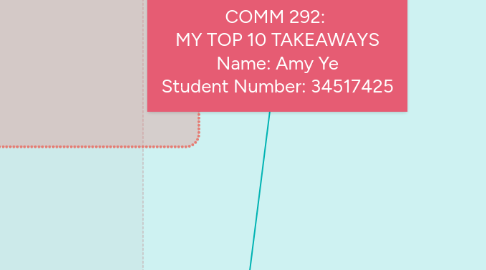
1. Group Level
1.1. Types of Teams
1.1.1. Problem-Solving Teams
1.1.2. Self-Managed Teams
1.1.2.1. Our COMM 292 would fit under the category of self-managed teams
1.1.2.1.1. We formed our own work schedules, and assigned tasks to group members based on their skills
1.1.2.1.2. This style worked best, as we were a small group, which made schedules and tasks simple to implement
1.1.2.1.3. This style allowed all the members to contribute their ideas, rather than have one member dominate the conversation
1.1.3. Cross-Functional Teams
1.1.4. Virtual Teams
1.1.4.1. Advantages
1.1.4.1.1. Virtual teams can benefit from employee diversity and ease of communication
1.1.4.2. Disadvantages
1.1.4.2.1. It is more difficult for employees to achieve a sense of belonging with the team
1.1.4.2.2. It may be difficult for employees to accommodate varying cultures into the team
1.1.4.2.3. The lack of channels with high communication richness may result in communication difficulties
1.2. Conflict
1.2.1. Dysfunctional Conflict
1.2.1.1. Relationship Conflict
1.2.2. Functional Conflict
1.2.2.1. Process Conflict
1.2.2.2. Task Conflict
1.2.2.2.1. Main conflict experienced by our COMM 292 team
1.2.3. Conflict Resolution
1.2.3.1. Forcing
1.2.3.1.1. Example: Dealing with an unruly child
1.2.3.2. Avoiding
1.2.3.3. Problem Solving
1.2.3.3.1. Example: During salary negotiations
1.2.3.3.2. Negotiation strategy most used by our COMM 292 team
1.2.3.4. Yielding
1.2.3.5. Compromising
1.2.4. Bargaining Strategies
1.2.4.1. Distributive Bargaining
1.2.4.1.1. Examples: Bargaining at a car dealer, or at an auction
1.2.4.2. Integrative Bargaining
1.2.4.2.1. Example: Mock salary negotiation exercise
1.2.5. Differences in Negotiation
1.2.5.1. Cultural
1.2.5.1.1. Example: Individuals typically negotiate better within cultures than between them
1.2.5.2. Individual
1.2.5.2.1. Example: Individuals with higher core self-evaluations may negotiate more effectively
1.2.5.3. Gender
1.2.5.3.1. A study found that males tend to negotiate higher salaries than females
1.3. Team Efficacy
1.3.1. Effective teams have confidence in their success
1.3.2. Cohesiveness is a feature of effective teams
1.3.2.1. Socio-emotional cohesiveness
1.3.2.1.1. Encouragement of cooperation
1.3.2.1.2. Emphasis on common characteristics
1.3.2.1.3. Consist of relatively few members
1.3.2.2. Instrumental cohesiveness
1.3.2.2.1. Clear and common goals
1.3.2.2.2. Contributions from every member
1.3.2.2.3. Recognition of every member's achievements
1.3.3. Effective teams are motivated towards team success
2. Organizational Level
2.1. Levels of Organizational Culture
2.1.1. Visible
2.1.1.1. Artifacts
2.1.1.1.1. Language
2.1.1.1.2. Material Symbols
2.1.1.1.3. Stories
2.1.1.1.4. Rituals
2.1.2. Hidden
2.1.2.1. Beliefs
2.1.2.2. Values
2.1.2.3. Assumptions
2.1.2.4. Organizational culture is like an iceberg; there are important hidden aspects to it
2.2. Functions of Organizational Culture
2.2.1. Conveys a sense of identity and belonging to members
2.2.2. Signals to members the expectations for behaviour that the organization maintains
2.2.3. Separates one organization from another
2.2.4. Motivates employees through company culture
2.2.4.1. Example: Pixar encourages creativity due to a culture that promotes open communication and innovative ideas
2.2.4.1.1. Pixar allows employees to fully customize their work stations, resulting in many creative -- and even outrageous -- designs
2.2.4.1.2. Pixar has open floor plans to encourage the cross-pollination of ideas between departments
2.2.4.1.3. Pixar allows their animators large amounts of control during movie projects
2.2.5. Conveys the organizations core values to members
2.3. Sustaining Organizational Culture
2.3.1. 1. Selection
2.3.1.1. Identifying and recruiting employees that fit the organization
2.3.2. 2. Socialization
2.3.2.1. Successfully integrating employees into the organization
2.3.2.2. i. Prearrival
2.3.2.3. ii. Encounter
2.3.2.4. iii. Metamorphosis
3. Individual Level
3.1. Perceptual Errors
3.1.1. Unconscious Biases
3.1.1.1. Attribution Theory
3.1.1.1.1. Fundamental Attribution Error:
3.1.1.1.2. Self-Serving Bias
3.1.1.2. Projection
3.1.1.3. Selective Perception
3.1.1.4. The Halo Effect
3.1.1.4.1. Example: A study found that participants were more likely to respect well-dressed individuals (for example, those wearing formal suits)
3.1.1.5. Contrast Effect
3.1.1.6. Stereotyping
3.1.1.6.1. Example: A study found that participants had a tendency to assume that the scientists wearing lab coats were more competent than ones dressed in regular clothing
3.1.1.7. Difficult to completely eliminate
3.1.1.8. Present in the majority of individuals
3.1.1.9. Result in unfair performance evaluations and expectations
3.1.2. Self-Fulfilling Prophecy
3.1.2.1. Unconscious biases can lead to the self-fulfilling prophecy becoming true
3.1.2.2. The phrase "fake it 'til you make it" describes the self-fulfilling prophecy
3.2. Motivation
3.2.1. Extrinsic Factors
3.2.1.1. Originate outside of the individual
3.2.1.1.1. Examples: Pay bonuses and tangible rewards
3.2.2. Intrinsic Factors
3.2.2.1. Originate from within the individual
3.2.2.1.1. Examples: Personal enjoyment and the desire the achieve one's goals
3.2.2.2. Intrinsic motivators are typically more meaningful and have greater impact than extrinsic ones
3.2.2.3. From personal experience, I am typically motivated by intrinsic factors compared to extrinsic ones
3.2.2.3.1. Personal example: Writing for enjoyment, compared to writing for a university course
3.3. Personality
3.3.1. The Big Five Personality Traits
3.3.1.1. Extraversion
3.3.1.1.1. Personally, I scored the lowest on this trait; this confirms my personal evaluation, that I am quite introverted
3.3.1.1.2. This is the aspect I will attempt to be the most aware of, and thus try to improve
3.3.1.2. Agreeableness
3.3.1.3. Conscientiousness
3.3.1.4. Emotional stability
3.3.1.5. Openness to Experience
3.3.1.5.1. Personally, I scored the highest on this trait
3.3.1.5.2. This confirms my own evaluation of my traits; I have always considered myself to be a fairly open-minded person
3.3.2. The Dark Triad
3.3.2.1. Machiavellianism
3.3.2.2. Narcissism
3.3.2.3. Psychopathy
3.3.2.4. The attributes that form the triad are not always necessarily negative
3.3.2.4.1. Example: Individuals with higher narcissistic attributes tend to have better core self-evaluations of themselves
3.3.2.4.2. While those with high levels of Machiavellianism are generally considered manipulative, those with moderate levels are often considered charismatic leaders

